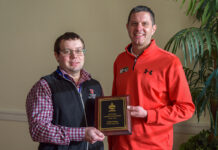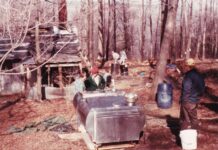
MINSTER, Ohio — The Village of Minster looks like any other small, rural Ohio town. There’s a grain elevator on the west end. The main street is lined with everything you need.
You actually might miss what makes it special if you’re not looking for it. Just outside of town to the west is the solar array. The solar panels sit facing the south on about 35 acres of former farmland.
The village installed a 4.2 megawatt solar photovoltaic array in 2015. The village’s second solar array just came on line in mid-January, adding another 4.6-megawatts of capacity. Solar creates 11% of Minster’s power, and that’s not counting what the new array will generate.
For Minster, it’s not as much about being environmentally friendly as it is about being energy independent and resilient. Solar is saving its customers money.
It’s also a good business move. Danone North America’s largest yogurt plant in the U.S. is in Minster. The more the village moves toward renewable energy, the more it, in turn, helps its largest business move toward its renewable energy goals.
“The Village of Minster is one of those communities that is forward thinking,” said Nicole Clune, a Minster councilwoman. “I’d consider it unique, the way the people of Minster are.”
The town
Minster is home to about 2,800 people. Driving down the main drag, there’s a grocery store, a bank, a post office, restaurants, a library, a police station and other small businesses. The streets are wide and open.
“We’re out in the middle of a bunch of corn fields, but we have a lot of industry in Minster,” said Don Harrod, village administrator.
There’s Nidec Minster, a company that makes punch presses for the automotive and beverage industry. Precision Strip Incorporated is the nation’s largest toll processor of metal in the country; the company was founded in Minster.
Then there’s Danone. What is now the largest yogurt plant in the U.S., taking up 58 acres on the southern end of town, started as the Meyer Dairy ice cream factory, a small dairy farm and ice cream maker. The plant makes Dannon brands like Oikos, Light and Fit and Danimals.
It’s also Minster’s biggest consumer of electricity and water. The Danone facility uses about 70% of the water generated in the village, Harrod said.
In part to help provide water for its largest customer, Minster built a new well field on a property it owned just to the west of the village, Harrod said. Except for a few well heads, the property was flat and vacant but couldn’t be used for conventional farming.

The power
Harrod said the solar panels started as a way to diversify the village’s energy portfolio and make the village more resilient. Minster is a municipal electricity provider. It has its own electric department and gets power in a couple ways.
Primarily, it works with a cooperative, American Municipal Power, or AMP, but sometimes it buys electricity straight from the market. AMP has 135 member communities in nine states, including Ohio, Pennsylvania, West Virginia, Indiana, Michigan, Kentucky, Virginia, Delaware and Maryland. It works with 85 municipalities in Ohio.
The coop owns or operates electric generation facilities for its members, including hydroelectric, solar, wind, natural gas and coal. Through AMP, Minster has part ownership in the Belleville Hydroelectric Plant, on the Ohio River, in West Virginia.
Before the solar panels came to rest on the west side of town, Clune said the village had been thinking about energy independence. They couldn’t go entirely off grid, but could they do it for a short amount of time in an emergency? What if a main transmission line feeding the town blew down in a windstorm? How long would it take for crews to fix the line in the remote part of Auglaize County?
That line of thinking was the start of the village looking into ways it could produce its own power.
The pitch
Around this time, the municipality was approached by a solar development company with a unique proposal. It seemed too good to be true. The company would develop and build a solar array for Minster. A financing partner would pay for and own the array, giving them the tax credits, depreciation benefits and income from the power generated by the array.
All Minster had to do was lease land for the project and sign a contract to buy all the power generated by the array for 30 years.
Clune said there was a lot of discussion within the council and administration about the project and the risks they’d be taking on, but they decided it was worth a shot.
Minster’s first solar array went in in 2015. It was developed by American Renewable Energy and financed by Half Moon. The arrays are on the property where the well field sits.
“You can’t develop on top of it,” Harrod said. “So, we took that well field and said, ‘Let’s put solar panels on it.’”
Eitri Foundry, a Florida-based solar engineering, procurement and construction company, developed the second phase of the solar array. It was financed by Madison Energy Investments.

Eitri has developed municipal solar projects for several other communities in Ohio, including Grafton, Monroeville and Montpellier. This sort of project is their bread and butter.
“When we started looking at markets to enter, there was a ton of money being made in Hawaii, New York, California, New England,” said Lian Niu, cofounder of Eitri Foundry. “We realized Ohio is a very underserved state.”
There weren’t as many developers targeting Ohio as a market for solar, Niu said. It wasn’t just an opportunity for them as a business, but it was an opportunity to bring renewable energy to municipalities and give communities more control over where their electricity comes from.
The perks
The solar array saves the municipality about $200,000 a year, Harrod said. Those savings get passed along to residents in the form of a lower electricity rate. Minster charges $.110 per kilowatt hour per month to residential customers.
The real savings come to Minster through transmission and capacity charges. For example, the village gets some of its electricity from the Niagara Power Project New York Power Authority. Minster must pay for the power to be transmitted to them from Niagara Falls.
The solar array is tied directly into the village’s system, eliminating the transmission charge.
They’ve seen additional savings during the summer. That’s when power usage is at its highest when people and businesses are trying to cool their buildings. Before the solar array, Minster would have to buy electricity on the market during these peak times, when customers were using more power than the village had available.
Summer is also when the sun is out the longest and shining the brightest to power the village’s solar panels.
The investment in clean energy is also good for Minster’s businesses. Danone North America has a goal of sourcing 100% renewable energy by 2030.
On top of the solar field, Minster’s total renewable energy portfolio is about 25% and growing.
“We are thrilled to see the village of Minster add newly built solar energy to their power portfolio and, as the largest consumer of energy in Minster, we’re working with the municipality to bring even more newly constructed renewable energy to our factory and to the municipality,” said Deanna Bratter, head of sustainable development at Danone North America, in a statement to Farm and Dairy.
The lessons
This sounds like a picture perfect story. A rural town invests in solar and sees big benefits and no drawbacks. Minster’s investment in solar earned it the title of Ohio Clean Energy Community of the Year in 2016, by Green Energy Ohio.
Could solar change every rural town in Ohio? It worked in Minster, because it’s a unique place. It’s a municipal electric provider. Its solar array is technically a behind-the-meter system, which is what a residential rooftop system is also considered. It’s generating power only for the village and not going out onto the greater grid.
As Clune pointed out, the village also had a good group of people working in the electric department, who were ready to take on the additional responsibilities that came with managing a solar field.

Also, Minster has a strong economy and big industrial customers, Niu said. The municipality has good credit. It could financially support such a project.
There’s also some risk involved. Minster signed a 30-year contract at a fixed rate to buy power from the solar array. If the price of producing electricity continues to increase, then it’s a good call. If, for some reason, the price of electricity drops precipitously, the village will be in a bad position.
For all the benefits solar has brought to the village, change is difficult.
“Solar panels aren’t corn,” Harrod said.
Lessons can be learned from how the community has embraced solar, however, and how the developers have worked within the community.
While most people were receptive to the project, some people wondered what it would look like and thought it might be an eyesore.
Swales, or large mounds of dirt, were put up on the southern side of the array, to block the view and reflection of the rays from the residents living near the system.
Niu said Eitri Foundry found that embedding in the community at the beginning of the project circumvents some of these common complaints about solar. The company meets with residents and fields questions and concerns.
If there are complaints about the solar panels being an eyesore, it’s usually an issue with something else, Niu said. The aesthetics are just an easy scapegoat. Listening to and responding to people helps them get the bottom of the issue and usually gets people on the side of solar.
“I feel like there’s something else that’s unaddressed,” Niu said. “It’s not the solar panels. Maybe it’s because they’re not happy with their end of the bargain, or they don’t feel like they were involved in the process.”
(Reporter Rachel Wagoner can be contacted at 800-837-3419 or rachel@farmanddairy.com.)










